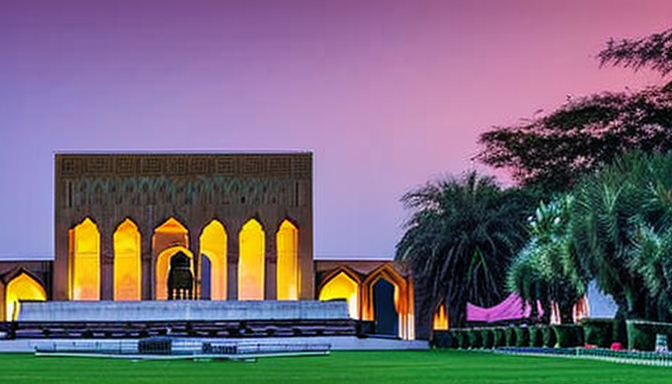Karachi is a city that never sleeps. It buzzes with life, energy, and a rich tapestry of history. When you stroll through its streets, you can’t help but notice the stunning monuments that stand tall, whispering tales of the past. Each building tells a story, a glimpse into the diverse cultures that have shaped this vibrant metropolis. From ancient mosques to colonial-era structures, these landmarks are not just bricks and mortar; they are the soul of Karachi.
Take a moment to imagine walking through the Frere Hall, with its impressive Gothic architecture. This landmark was built in the 1860s and is a testament to the British colonial influence. It’s like stepping back in time. Or consider the Mohatta Palace, a stunning blend of Islamic and Rajput architecture, which once served as a summer retreat for a wealthy businessman. Today, it stands as a museum, showcasing the rich history of the region.
But the beauty of Karachi’s monuments is not just in their design. They are woven into the fabric of everyday life. Locals gather around them, tourists snap photos, and children play in their shadows. These sites are more than just attractions; they are cherished parts of the community. So, whether you’re a history buff or just curious, exploring these architectural gems will certainly enrich your understanding of Karachi’s vibrant identity.
Historical Significance
Karachi is not just a bustling metropolis; it’s a treasure trove of history. The city’s monuments tell stories of its past, reflecting the rich tapestry of cultures that have influenced its development. From ancient times to the modern era, these structures have witnessed the evolution of Karachi, making them significant not only as landmarks but as symbols of the city’s identity.
Take, for example, the stunning Muhammad Ali Jinnah’s Mausoleum. This grand structure isn’t just a resting place; it’s a testament to the vision of Pakistan’s founder. Its white marble exterior and beautiful gardens speak of the respect and admiration held for Jinnah. Similarly, the Frere Hall, with its Gothic architecture, stands as a reminder of British colonial influence, showcasing the blend of cultures that defines Karachi.
But it’s not just about the buildings. Each monument holds stories of the people who walked its grounds. The Masjid-e-Tooba, known for its stunning dome, is a gathering place that resonates with the prayers and hopes of countless individuals. These structures invite us to reflect on our shared history and the diverse heritage of the city.
In essence, Karachi’s monuments serve as a bridge between the past and the present. They remind us of where we came from and inspire us to look forward. So, next time you stroll through this vibrant city, pause and appreciate the stories these historic buildings have to tell.

Architectural Marvels
The city of Karachi is a treasure trove of architectural wonders. Each monument tells a story, whispering tales of the past through its intricate designs. From grand mosques to colonial buildings, these structures are more than just bricks and mortar; they are a testament to the city’s rich cultural tapestry.
Take a stroll through the streets, and you’ll encounter the stunning Frere Hall. Built in the 1860s, this building showcases a beautiful blend of Gothic and Venetian architectural styles. Its lush gardens and iconic clock tower make it a perfect spot for a leisurely afternoon. Have you ever wondered how many stories those walls could tell?
Next, we have the magnificent Mohatta Palace. This stunning structure, built in the 1920s, features a unique blend of Rajasthani and Islamic architectural styles. Its vibrant pink stone and intricate carvings are truly eye-catching. Visiting this palace is like stepping back in time, where every corner reveals a piece of Karachi’s history.
Karachi’s mosques also stand out, with the Masjid-e-Tooba being a prime example. Known for its massive dome, it’s one of the largest single-dome mosques in the world. The simplicity of its design, combined with its vastness, creates a serene atmosphere that draws visitors from all walks of life.
In essence, Karachi’s architectural marvels are not just buildings; they are the heartbeats of the city, reflecting its diverse heritage and the many cultures that have shaped its identity. So, next time you find yourself in Karachi, take a moment to appreciate these magnificent structures. They are waiting to share their stories with you.
Frequently Asked Questions
- What are the most famous monuments in Karachi?
Karachi is home to several iconic monuments, including the Quaid-e-Azam’s Mausoleum, Mohatta Palace, and the Frere Hall. Each of these sites tells a unique story about the city’s rich history and cultural heritage.
- Why are these monuments important?
These monuments are not just architectural marvels; they represent the diverse cultures and historical events that have shaped Karachi. Visiting them offers a glimpse into the past and helps preserve the city’s identity for future generations.
- Can I visit these monuments?
Absolutely! Most of Karachi’s monuments are open to the public, and many offer guided tours. It’s a fantastic way to learn about their history and significance while enjoying the stunning architecture.
- Are there any entry fees for visiting these sites?
While some monuments may charge a nominal entry fee, many are free to visit. It’s always a good idea to check ahead of your visit for any updates on fees or special events.
- What should I know before visiting?
Dress appropriately, respect the site’s rules, and consider visiting during off-peak hours for a more enjoyable experience. Don’t forget your camera; you’ll want to capture the beauty of these historical treasures!